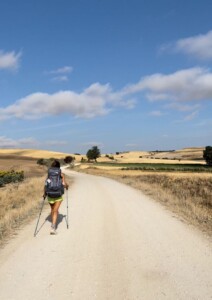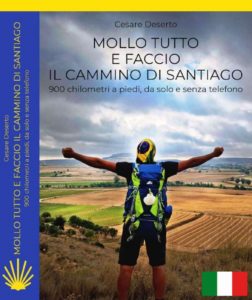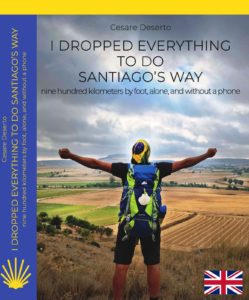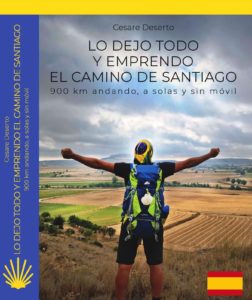My dear pilgrims, I will immediately answer the first question: NO, it is not dangerous. Just think that in recent years the presence of women has been higher than that of men (51.15%) according to the data provided each year by the Santiago de Compostela Pilgrim Reception Office and this number is destined to increase year by year. Many women leave alone, many are the girls I met as soon as they come of age, so my dear aspiring pilgrim should you worry about the possibility that the Camino de Santiago hides dangers, the fact that many women decide to take this itinerary should reassure you. All the precautions and common sense you apply every day in your city are largely sufficient to prevent any kind of problem. In any case, the Guardia Civil (the Spanish police) is always available and patrols the Camino even up close, both by car and motorbike. As in all European Union countries, the telephone number to call in an emergency is 112, although there are also others, already present before the establishment of the single European number: 091 – police; 061 – medical emergency; 080 – fire brigade; 092 – local police. Remember that if you need to call other types of telephone numbers, you must prefix the Spanish international prefix: +34 (or 0034). If these reassurances of mine are not enough for you and you want to stay SUPER QUIET, there is an application called “AlertCops” which integrates a system called “Guardian Benemérito”, specific for the Camino de Santiago, which allows the geo-localization of pilgrims who voluntarily activate it. on their phones. The app shares the last 10 GPS positions with an operations center that operates 24 hours a day every day of the week. In this way, the path followed will be traced, the status of the battery and the coverage of the mobile device will be made known and, in case of danger, any intervention will be coordinated. The app is available on both Android and Apple devices. My other reassurance is: don’t be afraid of getting lost.  The signposting of the trails, in particular that of the French Way, is up-to-date and easy to follow. In case you do not find any of the signs or signs with yellow shells and arrows (rarely happened in over 900 km), you will most likely find some other pilgrim along the same itinerary as you or someone to ask. The inhabitants of the place are almost always kind people and willing to help, being also used to seeing dozens and dozens of pilgrims pass every day. Don’t be afraid to talk to them or ask for help as they most likely already know what you are about to ask before you even approach and will immediately point you in the right direction without you needing to say a word. It may even happen that some motorists, seeing you in difficulty, point out the right path from the moving car with a nod! If this is not enough for you, there is an application called “Camino de Santiago (Buen Camino) where you will find the guide for the Camino de Santiago and the different routes of the itineraries with all the possible variations, on foot and by bike, on maps. Google or maps downloadable on your mobile, to surf without needing to connect to the Internet. You will also see your position on the map in real time so as not to get lost, a stage planner to organize the itinerary in your own way, alerts on problems or changes to the Way in real time, with daily updates from the journalists of the Buen Camino publishing house. There are thousands of geolocated points with all types of accommodation (hostels, pensions, inns), points of interest and important notices. The App provides by default the free guide of the Baztán Way, the French Way, the Portuguese Way (from Tui), the Aragonese Way, the Primitive Way, the Prolongamento towards Fisterra-Muxia and the Northern Way. All developed in Spanish, English, French, German and Italian. Another question that many women but also men have asked me is whether it was necessary to purchase an insurance policy before leaving. In principle, the answer is no, as long as you are European, as one of the potential major expenses, the health one, is covered by the European health card. Obviously, there are other possible unforeseen circumstances that can be covered by travel insurance: early repatriation costs, third party liability costs, interruption of stay, personal accidents, loss of luggage by the airline, purchase of basic necessities in case of late delivery of the backpack at the airport. In short, the risks one could run into on any other trip. Of course, the hope is to never need it, as it would represent an additional expense, but let’s face it: leaving knowing that you are protected in case something should happen is not so bad!
The signposting of the trails, in particular that of the French Way, is up-to-date and easy to follow. In case you do not find any of the signs or signs with yellow shells and arrows (rarely happened in over 900 km), you will most likely find some other pilgrim along the same itinerary as you or someone to ask. The inhabitants of the place are almost always kind people and willing to help, being also used to seeing dozens and dozens of pilgrims pass every day. Don’t be afraid to talk to them or ask for help as they most likely already know what you are about to ask before you even approach and will immediately point you in the right direction without you needing to say a word. It may even happen that some motorists, seeing you in difficulty, point out the right path from the moving car with a nod! If this is not enough for you, there is an application called “Camino de Santiago (Buen Camino) where you will find the guide for the Camino de Santiago and the different routes of the itineraries with all the possible variations, on foot and by bike, on maps. Google or maps downloadable on your mobile, to surf without needing to connect to the Internet. You will also see your position on the map in real time so as not to get lost, a stage planner to organize the itinerary in your own way, alerts on problems or changes to the Way in real time, with daily updates from the journalists of the Buen Camino publishing house. There are thousands of geolocated points with all types of accommodation (hostels, pensions, inns), points of interest and important notices. The App provides by default the free guide of the Baztán Way, the French Way, the Portuguese Way (from Tui), the Aragonese Way, the Primitive Way, the Prolongamento towards Fisterra-Muxia and the Northern Way. All developed in Spanish, English, French, German and Italian. Another question that many women but also men have asked me is whether it was necessary to purchase an insurance policy before leaving. In principle, the answer is no, as long as you are European, as one of the potential major expenses, the health one, is covered by the European health card. Obviously, there are other possible unforeseen circumstances that can be covered by travel insurance: early repatriation costs, third party liability costs, interruption of stay, personal accidents, loss of luggage by the airline, purchase of basic necessities in case of late delivery of the backpack at the airport. In short, the risks one could run into on any other trip. Of course, the hope is to never need it, as it would represent an additional expense, but let’s face it: leaving knowing that you are protected in case something should happen is not so bad!
To deepen the subject, to find out more and if you too have decided to walk the Camino de Santiago or dream of wanting to do it sooner or later, I suggest you buy my book where you will find out why every year, 300,000 people from all over the world, they decide to tackle the most famous Way in the world. If you too, like me, have always dreamed of giving up everything, aware that the life you lead is not the one you dreamed of as a boy, perhaps my experience could give you the courage that I lacked for 36 years …
Reading my experience, you will discover in detail and above all proven in the “field”:
- the history of the journey (historical notes, symbols and legends) and symbolic places;
- suitable clothing and shoes, which backpack to buy and above all what to put inside;
- duration and distance of the journey, how many days it takes to complete it and where to start based on the days available;
- how to train before leaving and the necessary physical preparation;
- how much does it cost to walk the path, where to eat and sleep along the path;
- whether walking the path alone can be dangerous for a woman and whether there is a possibility of getting lost;
- the answer to many questions and concerns (which were also mine) posed by many aspiring pilgrims and the possibility of contacting me to dispel all your doubts / hesitations;
- finally, I will tell you why a journalist and radio host gave up his whole life of comfort and materiality, to travel more than 900 km on foot from the Pyrenees to the Atlantic Ocean, alone and without a telephone, sleeping over that in the various hostels also on the street, in a stable, in a tent, in an abandoned monastery and living two days in a hippie community.
…. “I gave up everything, I left home, sold my car, motorcycle, clothes, my rolex and most of the material things I owned to follow that almost nagging, suffocating, undeterred feeling that once known does not make you find peace: SANTIAGO, the Camino de Santiago. My life needed answers that only a journey in complete solitude could give me “….
If you want to get to know me better, in the link below you will find an interview where I talk about my experience 👇👇👇
https://www.italianmadhouse.com/libri/i-dropped-everything-to-do-santiagos-way-cesare-desertos-book/




